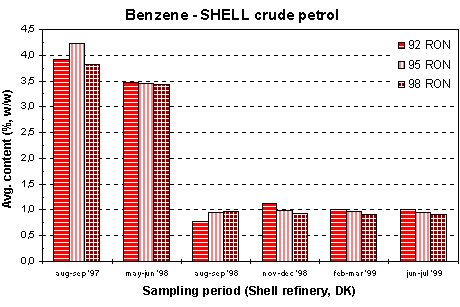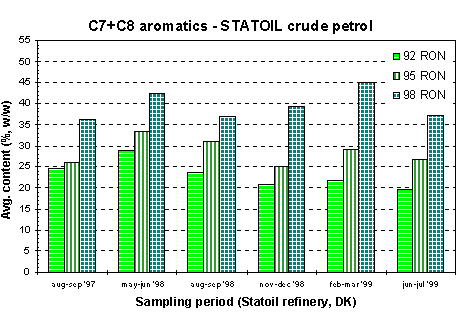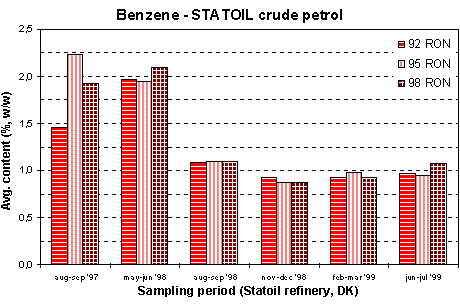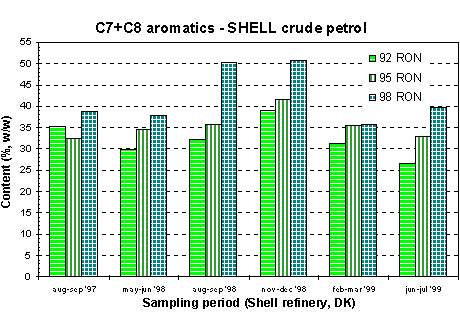[Front page] [Contents] [Previous] [Next] |
Benzene from traffic
2. Analysis of petrol
2.1 Method of analysis
2.2 Sampling of petrol
2.3 Sample preparation and analysis
2.4 Results of crude petrol
2.5 Results of retail petrol analyses
Aromatics in petrol
All samples of crude petrol of different qualities (i.e. 92 RON, 95 RON and 98 RON) and of unleaded retail petrol of the same three qualities from five major companies in Denmark were analysed by gas chromatography (GC) for the content of benzene and C7+C8 aromatics (BTX) quantified. Relative concentrations were then derived on a weight/weight (% w/w) basis as presented in the following sections. Reported values are slightly different from those typically reported on a volume/volume (% v/v) basis.
2.1 Method of analysis
GC/MS analysis
Benzene and other monoaromatics in petrol are usually analysed and quantified by gas chromatography (GC), as described in Kumar et al. (1986), ASTM Method D5580 (1994) and Martinez et al. (1996), or by gas chromatography mass-spectrometry (Mathiesen and Lubeck, 1998). Petrol contains hundreds of compounds, and co-elution of specific compounds is often observed unless special care is taken, e.g. by employing GC columns with enhanced separating capability (special PONA columns). This, however, does not entirely preclude co-elution, e.g. of benzene and methylcyclopentene present in cat-cracked products. Therefore, analyses of aromatics in petrol are often performed using relatively polar columns that has the resolution power necessary to separate aromatics from other groups of compounds (like paraffins, naphthenes and olefins).
Column type
In this project petrol analyses have been carried using a polar column of the type TCEP (1,2,3-tris-(2-cyano-ethoxy)-propane) by which benzene is retained till after the elution of undecane (C11-paraffin). Hence, practically all compounds eluting after benzene were aromatics and co-elution of olefins and aromatics avoided. At the same time a good separation of C7+C8 monoaromatics like benzene, toluene, ethylbenzene and xylenes (BTX) was achieved.
2.2 Sampling of petrol
Crude petrol
Crude petrol of three different qualities, 92 RON, 95 RON and 98 RON, for this project was sampled and delivered by the two refineries in operation in Denmark, Statoil in Kalundborg (East Denmark) and Shell in Fredericia (West Denmark). Sampling of crude petrol from Statoil was performed at the terminal close to Copenhagen (Hedehusene), which has a direct pipeline from the refinery in Kalundborg.
Sampling
Crude petrol was sampled in 1 L alumina bottles delivered by NERI to the refinery/terminal, and after sampling the bottles were returned to NERI. Sampling bottles were filled to the top to prevent extensive generation of headspace gases. During the project sampling of crude petrol took place during the following periods: August/September 1997, May/June 1998, August/September 1998, November/December 1998, February/March 1999 and June/July 1999, see also figure 7, chapter 3.
Retail petrol
Samples of retail petrol of the same three qualities as for crude petrol (i.e. 92 RON, 95 RON and 98 RON) were collected at five different petrol stations in Roskilde, Statoil, Shell, Q8, Hydro/Texaco and DK Benzin, during the following five periods: May/June 1998, August/September 1998, November/December 1998, February/March 1999 and June/July 1999. Before the actual sampling took place approx. 0,5 L was pumped to a waste container. Then the samples were collected in 1 L alumina bottles by continuing pumping. To reduce evaporation during sampling the piston was put as deeply into the bottle as possible. Again bottles were filled to the top to prevent generation of headspace gases and closed tightly. After collection all samples were sent to NERI where they immediately were cooled to and kept at -18°C until the time of analysis.
2.3 Sample preparation and analysis
Preparation
The content of benzene and C7+C8 monoaromatics (i.e. BTX) in collected petrol samples were quantified by gas chromatography (GC) using a combination of internal and external standards. First the GC system was calibrated by determining response factors for benzene, toluene and xylene using an internal standard (2-fluoro-toluene or 1,3-dichloro-benzene). Next petrol samples diluted in pentane containing the internal standard were analysed and the content of benzene, toluene, ethylbenzene and xylenes quantified on basis of the appropriate response factors, i.e. benzene (benzene), toluene (toluene), ethylbenzene and xylenes (xylene).
GC/FID analysis
All samples were analysed on a HP 5890 GC comprising a flame ionisation detector (FID) and a HP autosampler in the splitless mode using a 60 m * 0,25 mm ID * 0,40 µm TCEP fused silica capillary column with helium (He) as carrier gas (150 kPa) and temperature programming from 35°C to 130°C.
Standards
All calibration standards and diluted petrol samples were analysed in dublicates or triplicates, and between different sets and different petrol qualities blank and quality control (QC) samples (BTX) were analysed. Calibration curves generally had correlation’s coefficients (r2) better than 0,999 just as QC samples had relative deviations from nominal values of less than 10%. Relative standard deviations between doublicates/triplicates were also generally below 10% and hence the overall uncertainty of estimation less than 10%.
2.4 Results of crude petrol
Collection of samples
Samples of crude petrol from both the Statoil and Shell refineries were collected during six different periods (summer and winter) from September 1997 to July 1999, thus also covering minor variations in composition due to seasonal adjustments of vapour pressure.
Benzene in crude petrol
The benzene content in crude petrol from the Statoil and Shell refineries are shown in Figure 1 and 2, respectively. Generally, the benzene content in all three examined qualities of crude petrol from both refineries was reduced during the period covered. For Statoil crudes the content was reduced from about 2% in 1997 to 1% in 1999, while for Shell products the reduction was more substantial by going from about 4% in 1997 to 1% in 1999.
|
| Figure 1 Average benzene content (%, w/w) in crude petrol from the Statoil refinery, DK, sampled and analysed in 1997-1999. |
 |
Figure 2 Average benzene content (%, w/w) in crude petrol from the Shell refinery, DK, sampled and analysed in 1997-1999. |
C7+C8 aromatics in crude petrol
Besides the determination of benzene the content of C7+C8 mono-aromatic compounds (i.e. sum of toluene, ethylbenzene and xylenes) has also been quantified as shown in Figure 3 and 4 for the Statoil and Shell crude petrols, respectively. Generally, the average content of aromatics in both Statoil and Shell crude petrol has remained relatively constant during the project period, although some variations with a slightly decreasing tendency may be observed. For both brands of crude petrol the aromatics content can be observed to increase with octane number, this trend being more pronounced for the Statoil products. However, the sum of aromatics (i.e. BTX) is generally higher in the Shell products compared to Statoil products, about 35% vs. 30%.
Figure 3 Average content (%, w/w) of C7+C8 aromatics in crude petrol from the Statoil refinery, DK, sampled and analysed in 1997-1999. |
 |
|
Figure 4 Average content (%, w/w) of C7+C8 aromatics in crude petrol from the Shell refinery, DK, sampled and analysed in 1997-1999. |
2.5 Results of retail petrol analyses
Collection of samples
As for crude petrol samples of retail petrol of the same three qualities as for crude petrol were collected from five different companies (petrol stations) in Roskilde, Denmark, and analysed for the content of benzene and other C7+C8 monoaromatic compounds (i.e. BTX). Figure 5 and 6 show the average (for all companies) content of benzene and C7+C8 aromatics, respectively.
Benzene in retail petrol
Figure 5 shows that the average content of benzene in retail petrol (from five petrol stations) for all three qualities has been reduced from about 2% in 1998 to about 1% in 1999. As for crude petrol this reduction took place during the summer of 1998, and this overall trend is observed for all three qualities (i.e. 92, 95 and 98 RON) examined. After the reduction the content was observed to remain constant at 1%.
 |
Figure 5 Average content of benzene in retail petrol from five different petrol stations in Roskilde, DK, sampled and analysed in 1998-1999 |
C7+C8 aromatics in
retail petrol
Figure 6 presents the average content of C7+C8 aromatics in retail petrol from the same five petrol stations in Roskilde. As for the crude petrol the content is observed to increase with increasing octane number, but with less variation. During the period covered a small decrease in the BTX content from about 32% in 1998 to about 28% in 1999 (average for all three qualities) could be observed. This is similar to the trend that was observed for crude petrol from both the Statoil and Shell refineries.
|
Figure 6 Average content of C7+C8 in retail petrol from five different petrol stations in Roskilde, DK, sampled and analysed during 1998-1999 |
Individual petrol stations
Appendix A gives the average results of both the benzene and C7+C8 aromatics content in retail petrol from each of the five petrol stations in Roskilde, i.e. Statoil (Figure A1 and A2), Shell (Figure A3 and A4), Q8 (Figure A5 and A6), Hydro/Texaco (Figure A7 and A8) and DK Benzin (Figure A9 and A10), from where retail samples have been collected during the five periods from 1998 to 1999.
[Front page] [Contents] [Previous] [Next] [Top] |


